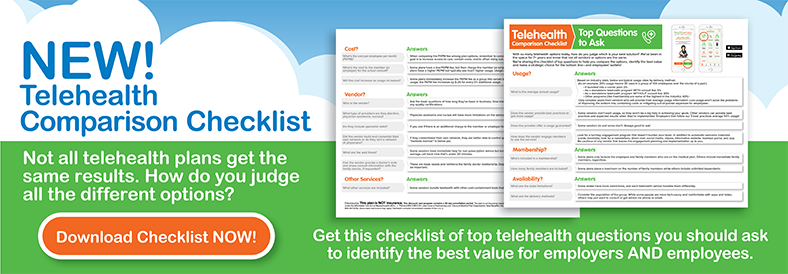CARES Act approves $0 Telehealth with HSA
It’s time for some good news. We don’t need a fancy lead-in, so let’s just get to it…
The CARES Act clarifies that a $0-visit-fee telehealth service is now valid alongside an HSA-qualified plan.
This has been a much-debated question in recent years, as it had not been previously codified into law or specifically allowed or disallowed by regulators. In fact, it’s one of the most-common questions we get from brokers and employers.
What was the issue?
HSA regulations state that an employer can't provide “significant care" before a qualified HDHP plan kicks in. The word “significant” is not specifically defined. So, the question became: is a $0 visit fee telehealth service considered significant care? Regulators have not answered this question, although millions of Americans have access to telehealth and HDHP plans.
Many attorneys believe telehealth is considered significant care and should only be installed if a visit fee is charged. Many other attorneys don’t consider telehealth as significant care and believe a $0 visit fee isn’t an issue. In the absence of a ruling, employers were left to decide.
What does the CARES Act say?
There are a number of points on the topic of Telehealth and Telemedicine in the $2 trillion Coronavirus Aid, Relief, and Economic Security (CARES) Act. Click here for an overview summary by the American Telemedicine Association (ATA). Most provisions are focused on provider infrastructure and clarifications for government-sponsored plans.
However, one section applies to employee benefit programs and HSAs. Specifically, the CARES Act “allows a high-deductible health plan (HDHP) with a health savings account (HSA) to cover telehealth services prior to a patient reaching the deductible.”
Ann Mond Johnson, ATA CEO, said, “We believe the bill reflects the scale of challenges we face as a country and recognizes that expanding virtual care is necessary to defeat COVID-19.” In an interview with HealthLeaders, she further expounded “All of a sudden, people are realizing that telehealth can be an incredible tool to get people access to care, to speed diagnosis, to get them treated if necessary, and to limit the risk of person-to-person exposure and spread of the disease.”
What is the specific language in the Bill?
Here is the exact language in Section 3701 of H.R. 748 – the CARES Act:
SEC. 3701. EXEMPTION FOR TELEHEALTH SERVICES.
(a) IN GENERAL.—Paragraph (2) of section 223(c) of the Internal Revenue Code of 1986 is amended by adding at the end the following new subparagraph:
“(E) SAFE HARBOR FOR ABSENCE OF DEDUCTIBLE FOR
TELEHEALTH.—In the case of plan years beginning on or before
December 31, 2021, a plan shall not fail to be treated as a high
deductible health plan by reason of failing to have a deductible for
telehealth and other remote care services.”.
(b) CERTAIN COVERAGE DISREGARDED.—Clause (ii) of section 223(c)(1)(B) of the Internal Revenue Code of 1986 is amended by striking “or long-term care” and inserting “long-term care, or (in the case of plan years beginning on or before December 31, 2021) telehealth and other remote care”.
(c) EFFECTIVE DATE.—The amendments made by this section shall take effect on the date of the enactment of this Act.
At freshbenies, we started working with telehealth (and other consumerism tools that help people control their healthcare) in 2009. A few innovative brokers were willing to come alongside me in those early years. Since then, we’ve coordinated hundreds of thousands of telehealth visits, and saved your clients over $80 million in unnecessary claims. While this might qualify us as experts, I’m not an attorney or an accountant, so please consult your legal counsel for clarification.
We’re excited about this new legislation. This comment from Ann Mond Johnson sums it up well and makes me smile: "Finally, regulation is beginning to catch up with what the technology can do."
















